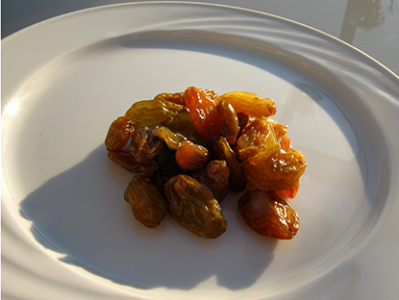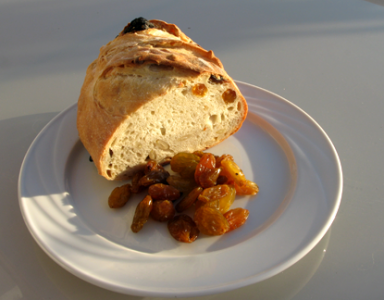NPR last week had a report on the extra-special bread people bake to celebrate Rosh Hashana, the Jewish New Year. I didn’t know that there are special shapes reserved for the New Year challah — round, for the cycle of the year — and that the bread is even sweeter. More to the point, I didn’t know that challah originally referred not to the whole loaf, but to a small portion that the baker removed and gave to the priests as an offering. These days, few bakers do that. But they do take a moment to reflect while holding the small piece of dough.
That’s a nice idea.

This story starts when my pal Joanne persuded me to reverse engineer a loaf she had bought at some swell place in NYC.1 That done I looked around for other similar recipes, and found one at YeastSpotting. Over time I’ve modified it a bit, mostly by removing the fresh yeast and relying entirely on my 100% leaven. This version makes two smallish loaves.
Ingredients
195 gm ripe 100% hydration starter. I build with ordinary soft flour
220 gm strong bread flour
220 gm durum flour
245 gm water
10 gm salt
22 gm olive oil
110 gm sultanas (seedless!) or raisins, or currants
70 gm pine nuts
10 gm fennel seeds (optional)
Method
Mix the starter, water, flours, starter and olive oil in a large bowl and mix until combined. Turn out onto the counter and knead for about 5 minutes to a smooth, elastic consistency. Add the sultanas or other dried fruit, the pine nuts and fennel seeds (if using) and knead until the additional ingredients are well incorporated into the dough.

Form into a ball and place into a lightly oiled bowl to bulk ferment for 2 hours.
Turn the dough out onto a lightly floured surface, press out gently and divide into two portions.2 Shape the dough as you prefer and allow to rise for about another 1 1/2 hours.
Preheat the oven to 230°C and prepare to use steam.
Slash the loaves and place them in the oven, with steam. Bake for about 10 minutes. Then remove the steam, turn the temperature down to 220°C and bake for a further 20 minutes. Test the loaves for doneness and if done turn the heat off and leave them in the oven with the door slightly ajar to help them dry out. Place on a wire grill to cool.
Durum loaves often dry quickly, but the sultanas help to keep this one softer longer. I like the contrast of the sweetish bread with salty salami and cheese. It also toasts well.
Notes
I caught the tail end of the Food Programme’s podcast on sourdough as I was working on a ripe biga, built from a genuine Tuscan pasta madre that I am assured has been going strong for more than a century. So I’m clearly part of the “major revival” of sourdough, which is “experiencing a renaissance”. Except that I’ve been baking sourdoughs for at least 20 years, when I first made my own starter. So there’s the problem that everyone has, when they listen to or watch a programme about something they actually know about. Most of it is bizarrely banal, but buried in there are plump raisins of new information.
One such was that San Francisco sourdough probably has nothing to do with those pesky goldrush miners. Erica J. Peters, independent food historian, explained that the ‘49ers were far too busy digging for gold, and far too close to civilisation, to bother with sourdough bread. It was the Yukon goldrush, 50 years later, that required miners to keep their precious starter warm and cosy tucked inside their clothes. Peters also attacked the story that Louise Boudin, of the Boudin Bakery, canonical home of San Francisco sourdough, saved a bucket of starter culture from the fire that followed the 1906 earthquake, which destroyed the bakery.
As a historian, I tend to think when the story is so adorable you can’t rely on it.
Does that mean it is or is not reliable? No idea.
As for banal, presenter Sheila Dillon seemed amazed that even though the bacterium is found in sourdoughs around the world, it is called Lactobacillus sanfranciscensis. She is briefed, I imagine. And the instructions on the programme website for how to make your own starter are not, in my view, very useful.
Not to quibble too much, it was a good programme (and there’s a longer write-up here). I found the explanations of how the yeast and the bacteria work together really good. And Andrew Whitley’s musings on the sourdough revival — simplicity is not as fashionable as complicated — struck a chord too, even though I think sourdough is in many ways simpler than yeast.
While I don’t believe a bit of it, I do like the stories that religions tell us. For example, I had no idea before this morning that September 14th is the day on which the Greek Orthodox church celebrates the discovery of the true cross. And what does that have to do with bread? It’s all down to the royal herb basil.
Aglaia – of Aglaia’s table – explained all in a recent blogpost. It was basil that indicated to St Helena and her son Constantine which among many was the true cross. And it is basil, according to Aglaia and her late mother-in-law, that makes bread rise.
Greek women believe that bread rises by divine intervention. If you tell them that a batter of flour and water will ferment from the various airborne microorganisms if left for a few days, they refuse to believe it. They are certain that only the direct power of God can turn a mere flour batter into a leavening medium. This is the reason why prozymi –the natural sourdough starter used in traditional baking– is usually made on September 14, or near the end of Holy Week, preceding Easter.
Aglaia experimented with different flowers in her flour and water. Some did make a difference, but not basil. Which matters not a bit.
Something strange happened to the RSS feed of Dan Lepard’s rather wonderful blog the other day, and I’m glad it did, because I got to see again his excellent post on types of flour. A sample:
If you push me, I‘ll explain that in the UK, strong flour is typically flour for breadmaking, and plain flour is flour for cakes and biscuits. But to be really honest, the truth is much more complex as I frequently use plain flour for bread recipes, and strong white flour for cake recipes.
Dan also explains what to substitute for what, and I particularly want to try his tip to add a little wholemeal flour to mostly white breads, for more additional flavour. He also points out that one reason to add sugar or malt is to sustain the yeasts during a longer fermentation, which is well worth bearing in mind.